Introduction
- Books Name
- CBSE Class 6 Science Book
- Publication
- Param Publication
- Course
- CBSE Class 6
- Subject
- Science
Introduction :
Light is the form of energy which makes object visible. It means that we can see an object only when light from an object enters our eyes. The light may have been emitted by the object or may have been reflected by it. You may have also seen beams of light from the torch, head light of vehicles.
Sources of Light :
Those bodies which emit light in all directions are called sources of light. The sources can be point one or extended one. The sources of light are of two types :
(i) Luminous sources : Those objects which by itself emit light are called luminous sources.
Eg. : Sun and stars (natural luminous sources), electric lamps, candles and lanterns (artificial
luminous sources).
(ii) Non-luminous sources : Those objects which do not emit light but become visible only when light from luminous objects falls on them. They are called non-luminous sources.
Eg. : Moon, planets (natural non- luminous sources), wood, table (artificial non-luminous sources) etc.
(iii) Bioluminescence : The production or emission of light by a living organism as a result of some chemical energy getting converted into light energy is called bioluminescence. The name originates from the Greek word bios for ‘living and the Latin word lumen for ‘light’.
Fireflies are insects that give off a pale, greenish-yellow light that flashes or glows in the dark . Some of the fish, such as angler fish, living deep under the sea are also bioluminescent.
Medium of light :
Substance through which light propagates or tends to propagate is called a medium of light.
According to the medium of light objects are divided into three parts :
(i) Transparent object :
Bodies that allow light to pass through them i.e. transmit light through them, are called transparent bodies.
Ex. : Glass, water, air etc.
(ii) Translucent object : Bodies that can transmit only a part of light through them are called translucent objects.
Ex. : Froasted or ground glass, greased paper, paraffin wax etc.
(iii) Opaque object : Bodies that do not allow light to pass through them at all are said to be opaque objects.
Ex. : Chair, desk etc.
CHARACTERISTICS OF LIGHT
Some common characteristics of light are given below:
(i) Light is invisible form of energy .
(ii) Light does not require material medium for its propagation i.e. light can travel through vacuum.
(iii) The speed of light in free space (vacuum) is 3 × 108 m/s. Its speed is marginally less in air. Its speed decreases considerably in glass or water.
(iv) Light undergoes reflection from polished surfaces such as mirrors etc.
(v) When light goes from one medium to another, it changes its path.This phenomena is called refraction.
Some definition related to the light :
(A) Ray of Light :
The path along which light energy travels in a given direction is called ray of light. A ray of light is represented as a straight line. The arrow head on it gives the direction of light.
![]()
(B) Beam of Light :
A collection of rays of light is called beam of light. However, if the number of rays is too small then such a collection of rays is called Pencil of light.
(C) Parallel Beam :
When the rays of light travel parallel to each other, then the collection of such rays is called parallel beam of light. For example, sun rays entering into a room through a ventilator constitute a parallel beam .

Transparent, opaque and translucent objects
- Books Name
- CBSE Class 6 Science Book
- Publication
- Param Publication
- Course
- CBSE Class 6
- Subject
- Science
Rectilinear propagation of light :
Light travels in a straight line. In vacuum or air, light travels with the velocity of 3 × 108 m/s.
Examples of rectilinear propagation of light in everyday life :
(i) When the sunlight enters through a small hole in a dark room, it appears to travel in straight lines.
(ii) The light emitted by the head light of a scooter at night appears to travel in straight lines.
(iii) If we almost close our eyes and try to look towards a lighted bulb, it appears to give light in the form of straight lines, which travel in various direction.
Shadow
A shadow is a dark outline or image cast by an opaque object that blocks light coming from a source of light.

(a) The cause of formation of shadows is
Rectilinear propogation of light (light travels on straight lines)
(b) Essentials of a shadow:
(i) Source of light
(ii) Presence of opaque object in the path of light
(iii) Screen on which shadow is formed
(c) Location of a shadow:
Shadow fills the space between the opaque object and the screen. It is the volume and not area on the screen.
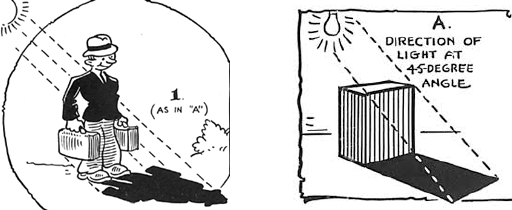
(d) Formation of shadow :
It is formed when light hits the opaque object which does not let the light pass through. Everywhere else around the opaque object, the light continues in a straight path until it bounces off the ground or wall behind the object. The wall or ground behind the opaque object is the screen. On this screen is a dark patch, or shadow, with the same outline as the object surrounded by light. The colour of the opaque object does not affect the colour of the shadow that is formed.
Shadow sticks :
A shadow stick is a vertical pole placed in the ground. Sunlight casts its shadow on to a level surface below.(e.g. a sheet of card or just level ground)

As the Sun moves from A to C, the shadow shortens and then lengthen accordingly
The length and position of the shadow then depends on both the time of year and the time of day. Local noon can be found from the time when the shadow is shortest. At this time the Sun is highest in the sky and crossing the meridian.
However, shadow sticks are not good clocks - the azimuth of the Sun’s shadow at a given time changes throughout the year with the Sun’s declination.
The shape, size and other characteristics of a shadow depend upon :
(i) Position and distance of the source of light with respect to the object.
(ii) The distance between the object and the surface on which the shadow falls.
(iii) The size of the source of light.
What exactly are shadows?
- Books Name
- CBSE Class 6 Science Book
- Publication
- Param Publication
- Course
- CBSE Class 6
- Subject
- Science
* A Shadow has two Regions :
For a non-point source of light (i.e., an extended source of light), the shadow of an object has two parts, namely, the umbra and the penumbra. The umbra is the darkest inner part of the shadow where no light falls at all. The penumbra is the part which surrounds the umbra. Some rays of light fall on this region and partially illuminate it. Thus, the penumbra is called the region of partial darkness.
(i) Umbra : The inner region of total darkness is called umbra.It is the evenly dark part of a shadow. Umbra means ‘shade’ in latin.
(ii) Penumbra : The outer region of partial darkness is called penumbra. It is the fuzzy part between the dark and the light . Pene means ‘almost’ in Latin.
Umbra and penumbra are clearly formed only when the source of light is big and opaque body is small.
If one is in the umbra of an object, the light source is completely obscured. If one is in the penumbra, the source is only partially obscured, to a greater or lesser degree as one moves through the penumbra.
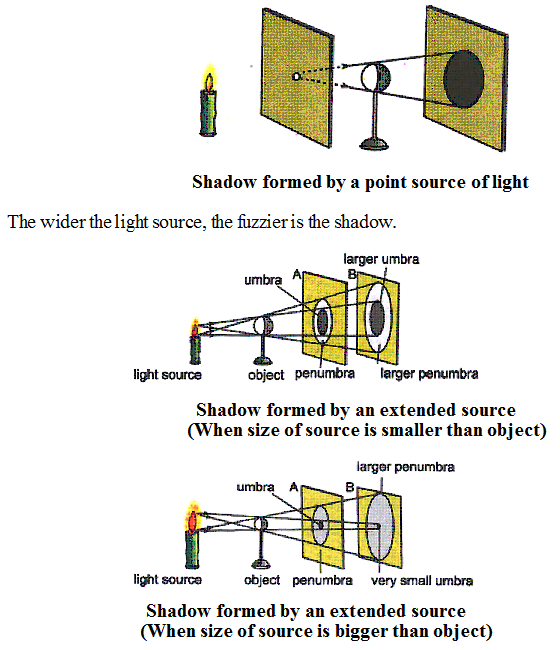
With a wider light source,the shadow becomes fuzzier Also, closer the object to the light, the larger and fuzzier is the shadow. In other words, the closer the object to the screen, the smaller and well defined is the shadow. Thus, the size of the umbra becomes smaller and smaller if the screen is moved farther and farther from the light source and the object.
Shadows are often fuzzy, particularly when the surface on which the shadow lies is far from the object casting the shadow. This fuzziness is because of only point light source in space. All sources have some geometrical size.Thus, light from one edge of the source is not quite parallel to light from the other edge
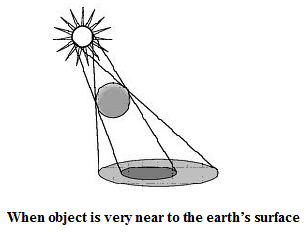
The result is a larger and fainter penumbra that is hardly visible. This is the reason why we cannot see the shadow of a bird flying high up in the air .
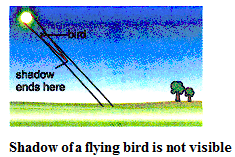
Shadow of same object is different for same source, because of the change in the postion of an object and light falling on different surface of an object for same source.
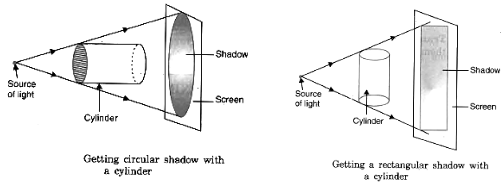
Behaviour of light at the interface of two media :
When light travelling in one medium falls on the surface of a second medium, the following three effects may occur :
(i) A part of the incident light is turned back into the first medium. This phenomenon is called reflection of light.
(ii) A part of the incident light is transmitted into the second medium along a changed direction. This phenomenon is called refraction of light.
(iii) The remaining third part of light energy is absorbed by the second medium. This phenomenon is called absorption of light.
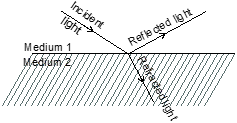
A pinhole camera
- Books Name
- CBSE Class 6 Science Book
- Publication
- Param Publication
- Course
- CBSE Class 6
- Subject
- Science
Reflection of light :
When a ray of light falls upon a smooth surface like a mirror, the ray of light is reflected in another direction in the same medium. This phenomenon is called reflection of light.
(a) General definitions about reflection :
(i) Mirror :
A smooth polished surface from which regular reflection can take place is called mirror. MM’ is the mirror as shown in figure.
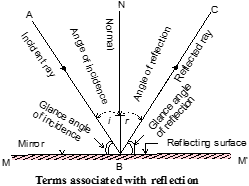
(ii) Incident ray :
A ray of light which travels towards the mirror is called incident ray. Ray AB is incident ray in figure.
(iii) Point of incidence :
The point on the mirror, where an incident ray strikes is called point of incidence. ‘B’ is the point of incidence in figure.
(iv) Reflected ray :
A ray of light which bounces off the surface of a mirror, is called reflected ray. BC is reflected ray in figure.
(v) Normal :
The perpendicular drawn at the point of incidence, to the surface of mirror is called normal. BN is the normal in figure.
(vi) Angle of incidence :
The angle made by the incident ray with the normal is called angle of incidence. ∠ABN is the angle of incidence in figure. It is denoted by ∠i.
(vii) Angle of reflection
The angle made by the reflected ray with the normal is called angle of reflection. ∠CBN is the angle of reflection in figure. It is denoted by ∠r.
(viii) Glance angle of incidence
The angle which the incident ray makes with the mirror is called glance angle of incidence. ∠ MBA is the glance angle of incidence in figure.
(ix) Glance angle of reflection
The angle which the reflected ray makes with the mirror is called glance angle of reflection.∠M’BC is the glance angle of reflection in figure.
Regular and diffused reflection :
When a beam of light falls on a smooth, highly polished surface, almost entire light gets reflected in the same medium in a definite direction. This type of reflection is called regular reflection. We can see our image formed by a mirror due to the phenomenon of regular reflection.

When a beam of light falls on an opaque, rough and uneven surface, the light gets reflected in different directions. This type of reflection is called irregular or diffused reflection. We can read a book or a newspaper due to diffused reflection.
Mirrors and reflections
- Books Name
- CBSE Class 6 Science Book
- Publication
- Param Publication
- Course
- CBSE Class 6
- Subject
- Science
Laws of reflection :
The reflection of light from a surface obeys certain laws called laws of reflection. They are :
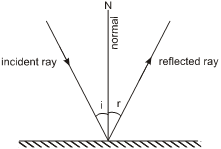
(i) The angle of incidence is equal to the angle of reflection. i.e., ∠i = ∠r.
(ii) The incident ray, the reflected ray and the normal at the point of incident, all lie in the same plane.
The laws of reflection are applied for all type of reflections.
Ex.1 Calculate the angle of reflection.
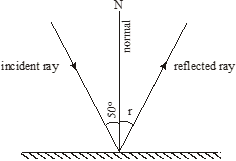
Sol. According to the law of reflection, incident angle equal to reflected angle. So angle of reflection ∠r = 50°.
Mirror :
It is a highly polished surface, which is quite smooth and capable of reflecting a good fraction of light from its surface.
(a) object :
Anything which gives out light rays (either its own or reflected) is called an object.
(b) Image :
The reproduction of object formed by mirror or lens is called an image.
Difference between image and shadow
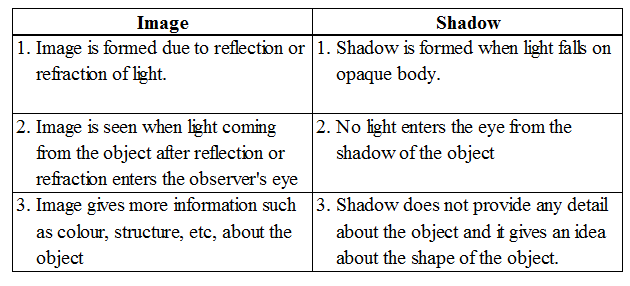
Pinhole Camera (Part -1)
- Books Name
- CBSE Class 6 Science Book
- Publication
- Param Publication
- Course
- CBSE Class 6
- Subject
- Science
Pinhole Camera
The word camera comes from the Greek kamara, a vaulted chamber. A pinhole camera is the simplest camera possible. It consists of a light-proof box, some sort of film and a pinhole. The pinhole is simply an extremely small hole like you would make with the tip of a pin in a piece of thick aluminium foil.
A pinhole camera works on a simple principle.
Imagine you are inside a large, dark, room-sized box containing a pinhole. Imagine that outside the room is a friend with a flashlight, and he is shining the flashlight at different angles through the pinhole. When you look at the wall opposite the pinhole, what you will see is a small dot created by the flashlight’s beam shining through the pinhole. The small dot will move as your friend moves his flashlight. The smaller the pinhole (within limits), the smaller and sharper the point of light that the flashlight creates.
Rays scatter off objects in all directions. The pinhole in the front of the camera selects only the rays traveling in the direction of the pinhole. These rays pass into the camera and strike the back surface.The front and side walls shade that point on the back from rays coming from different points of origin.
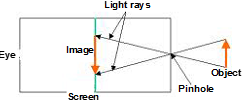
A pinhole camera casts an inverted image on the back. This image will also be slightly blurry, because light coming from one atom on the object spreads out over the back of the camera according to the size of the pinhole. Each disk of light casts onto the back overlaps and blurs with disks from nearby atoms.
One can reduce the blur by making the pinhole smaller. However, then the image becomes darker and may not be visible or recordable on film.
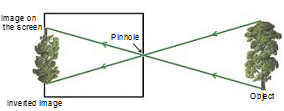
Extended Learning – Activities and Projects
1. Phenomenon of path travelled by light and reflection of light from mirror.
Fix a comb on one side of a large thermocol sheet and fix a mirror on the other side as shown in the figure. Spread a dark-coloured sheet of paper between the mirror and the comb. Keep this in sunlight or send a beam of light from a torch through the comb. What do you observe? Do you get a pattern similar to that shown in the figure?
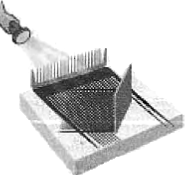
Light travels in straight line and gets reflected from the mirror. Yes, we get a pattern similar to that shown in the figure.
2. To observe the path of light.
• Take a chart paper and roll it into a pipe. Look at a lighted candle through it as shown in. Take care not to touch the chart paper with the flame.
• Now bend the pipe from the middle and repeat the activity as shown in. Why are you not able to see the lighted candle through the bent pipe?
Light travels in a straight line and does not bend with the pipe.

Pinhole Camera (Part -2)
- Books Name
- CBSE Class 6 Science Book
- Publication
- Param Publication
- Course
- CBSE Class 6
- Subject
- Science
3. Phenomenon of a mirror changes direction of light that falls on it.
This activity should be done at night or in a dark room. Ask one of your friends to hold a mirror in his/her hand at one corner of the room. Stand at another corner with a torch in your hand. Cover the glass of torch with your fingers and switch it on. Adjust your fingers with a small gap between them so that you can get a beam of light. Direct the beam of the torch light onto the mirror that your friend is holding. Do you see a patch of light on the other side?
Now, adjust the direction of the torch so that the patch of light falls on another friend standing in the room. This activity suggests that a mirror changes the direction of light that falls on it. Here is an activity that shows light travelling along straight lines and getting reflected from a mirror.
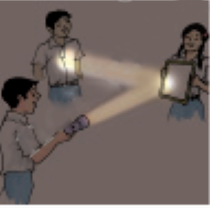
4. To prove that smooth and shiny surfaces reflect light better.
• Place objects like a mirror, a shiny steel plate, a plastic plate or a sheet of paper near a screen which can be a wall or a paper sheet.
• Shine a beam of light through a torch on these objects in such a way that reflected light falls on the screen as shown in figure.
You will observe that in case of the plate mirror, a bright patch of light is seen on the screen. Similarly, in case of the steel plate, a patch of light is visible on the screen. But when you use a paper sheet, no patch of light can be seen on the screen.
Shiny and polished objects like steel plate, mirror, polished wood piece, etc. reflect more light and form a brighter patch on the screen. Rough and dull surfaces, on the other hand, reflect less light and do not make a patch on the screen.
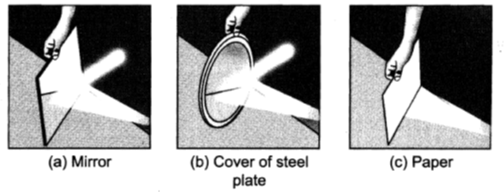
5. Phenomenon of shadow formation.
(a) Place a chair in the school ground on a sunny day. What do you observe from the shadow of the chair? Does the shadow give an accurate picture of the shape of the chair? If the chair is turned around a little, how does the shape of the shadow change?
No, accurate shape of chair is not shown by the shadow. When turned around a little, the shape of the shadow will change because now different portions of the chair will obstruct light and make shadow.
(b) Take a thin notebook and look at its shadow. Then, take a rectangular box and look at its shadow. Do the two shadows seem to have a similar shape?
Yes, the two shadows seem to have a similar shape.
(c) Take flowers or other objects of different colours and look at their shadows such as a red rose and a yellow rose for instance. Do the shadows look different in colour, when the colours of the objects are different?
No, the shadows of the different coloured objects are not different.
(d) Take a long box and look at its shadow on the ground. When you move the box around, you, may see that the size of the shadow changes. When is the shadow of the box the shortest, when the long side of the box is pointed towards the Sun or when the short side is pointing towards the Sun?
Shadow of the box is the shortest when the short side is pointing towards the Sun.
Points to Remember
- Books Name
- CBSE Class 6 Science Book
- Publication
- Param Publication
- Course
- CBSE Class 6
- Subject
- Science
Points to remember
1. Source of light: An object which emits light, is called a source of light. For example, sun, torch, etc.
2. Non-luminous objects: These are the objects which do not emit light of their own. Such a body becomes visible when light falls on it. For example, the moon, the planets, etc.
3. Ray of light: A straight thin beam of light from a source to an object is called a ray of light.
4. Obstacle: An object which comes to the path of the light is called an obstacle.
5. Formation of a shadow
(i) All the opaque objects seem to form a dark shadow of their own.
(ii) We need a source of light, an opaque object in the way, and a screen to see a shadow.
(iii) Screen: This is a surface on which the :shadow is formed. It maybe a butter paper or simply ground.
(iv) Shadows give us some information about shapes of objects.
(v) The colour of the opaque object does not affect the colour of the shadow.
(vi) All the space behind the opaque object, up to some distance behind it seems to be filled with·the shadow.
6. Image formed by a pinhole camera
(i) Images formed by a pinhole camera are upside down. Here is a picture showmg the path of rays of light coming from an object far away to a pinhole and then to screen.
(ii) When sunlight passes through the leaves of a tree, the gaps between the leaves act as the pinholes. These natural pinholes cast nice round images of the sun.
7. Rectilinear propagation: Light travels in a straight line. It is called rectilinear propagation of light.
8. Image formation by a plane mirror: We are able to see images through a mrrror. Image formed by a mirror (flat) has following features:
(i) Reflected image retains the colour of the object.
(ii) Image is erected but laterally inverted.
9. Lateral inversion: Right side of the object appears as left side in the image formed by a plane mirror. For example, if we show our right hand image in the mirror will show as left hand.

10. In a mirror, if you see another person, surely the other person can also see you in that mirror.
Keywords
1. Luminous: Objects that give out or emit light of their own are called luminous objects.
2. Mirror: A smooth shining surface, which rebounds the light back in same or in different directions is called a mirror.
3. Opaque objects: If an object completely stops the passage of all the light falling on it, it is an opaque object.
4. Pinhole camera: It is a device which forms a photograph-like image of a bright object on a screen.
5. Reflection of light: When a ray of light falls on a smooth and polished surface, light returns back in the same medium. It is called reflection.

6. Shadow: Opaque objects do not allow light to pass through them and cast dark patches behind them. These dark patches are called shadows.
7. Translucent objects: Some objects allow only a part of light falling on them to pass through, such objects are called translucent objects. For example, a single thin sheet of paper.
8. Transparent objects: Those objects which allow all the light to pass through them are called transparent objects.

 Param Publication
Param Publication
 PathSet Publications
PathSet Publications
